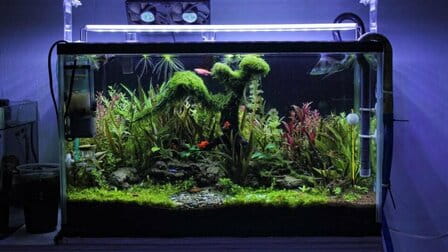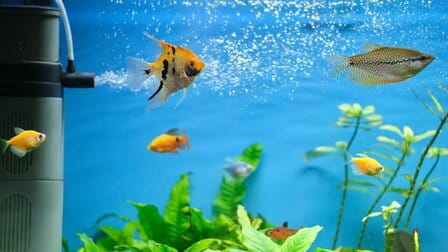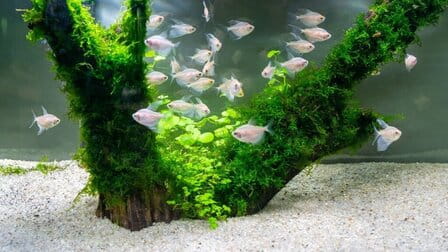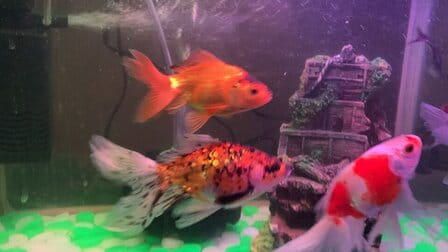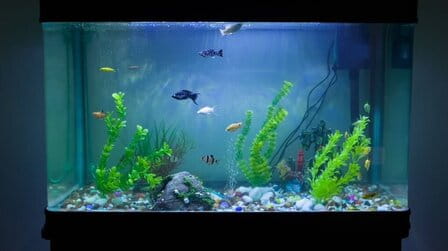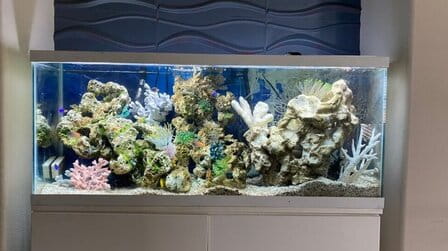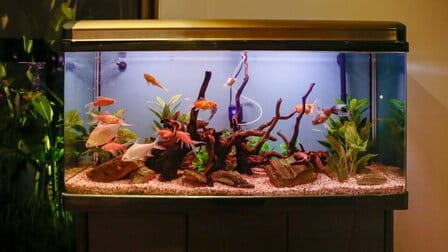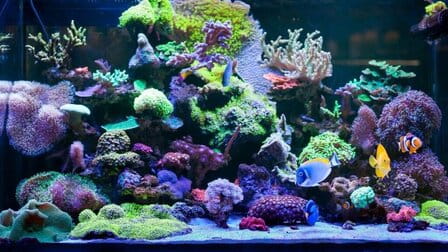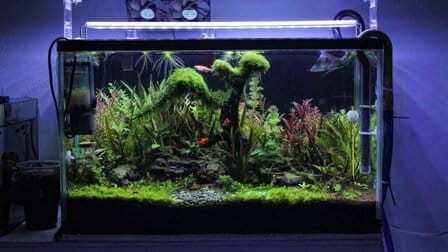The air pump may aerate and oxygenate the water. Oxygen is required for fish and plants in general. The fish will grow anxious if there isn't enough oxygen in the tank. Because most air pumps have just one output, they don't need to be assembled. The newest air pumps come with many outlets, and if you have one with two outlets and want to set up one air stone in your aquarium, we’ll show you how to do it in this article this manual.
How to Set Up Aquarium Air Pump
First and foremost, you require the appropriate equipment. The aquarium air pump is the most important piece of equipment for pumping air. The air pump, on the other hand, cannot accomplish the task on its own. And here are some steps how to set up aquarium air pump:
Locate an appropriate place for the air pump
To begin, set the air pump close to the aquarium but not too close. The aquarium air pump is not watertight because it is an electrical equipment. You must not allow it to fall into the water or become wet.
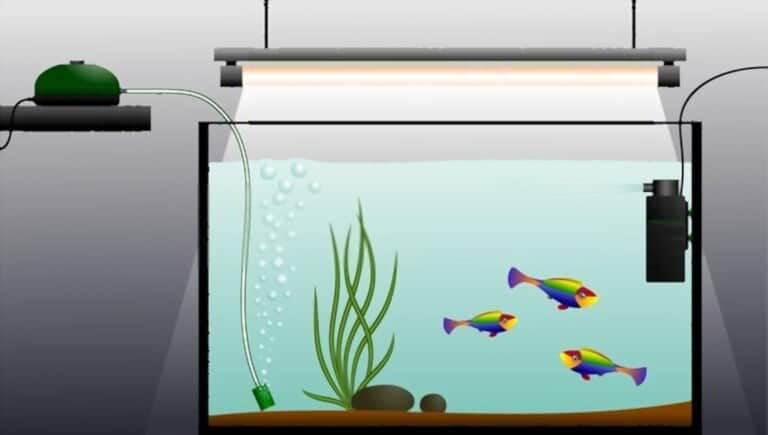
So choose a location where the air pump may be higher than the tank without being exactly over it. In the event that it is dropped, it will not fall into the water. It also necessitates the use of an electrical outlet.
Connect the air pump to the air tubing
There isn't much to say at this point, and it's rather straightforward. All you have to do now is make sure the air duct is long enough to reach the tank.
Add a check valve

It's also critical that we cut the air duct someplace outside the tank. Then, in the middle, put the check valve. This valve will properly join both sides. In the case of a power outage, the check valve allows air to flow through while preventing water from pouring back into the air pump.
Connect the air pump to an electrical outlet and switch it on after everything is in place. The air pump will assist in pushing air all the way to the airstone through the air duct. When the air arrives, the pressure drives it through the many microscopic pores in the air rock, causing bubbles to form.
Benefits of Aquarium Air Pump
. If you know how to set up an aquarium air pump, you should consider the benefits of an aquarium air pump. In the aquarium, air pumps provide a variety of functions. Air pumps can be used to deliver oxygen, circulate water, power decorations, and power filtration systems:
Fresh Air for Your Aquarium
An aquarium air pump has traditionally been one of the most simple but adaptable pieces of aquarium equipment available. An aquarium air pump's primary duty is to mechanically transport air from the atmosphere into your aquarium.

It works by pumping air into the water, creating water movement with rising air bubbles while also providing oxygen to the water, which your aquarium fish and animals require to "breathe." You can considerably improve the effectiveness of the air entering the aquarium while also improving its appearance.
Aeration
As previously said, fish, like animals, require oxygen to exist, which they obtain from aquarium water. They achieve this by using their gills to collect dissolved oxygen from the water. Although aquariums may collect oxygen from the water's surface, this may not be sufficient.
It is not difficult to dramatically enhance CO2 and O2 exchange using a pump while maintaining safe dissolved amounts of both gases. The direct transfer of gases from the created bubbles, as well as the surface agitation caused by the fleeing bubbles, causes this.
Decoration
People frequently place an Air Stone (driven by an air pump) in their aquarium merely to create a stream of lovely tiny bubbles. Air stones come in a variety of forms and sizes, as well as useful decorations with air pumps. For added drama, some Air Stones and decorations include LED illumination.
Filters
In addition to the benefits listed above, the bottom filter, sponge filter, and several other filters are powered by an air pump. Water movement is created by air bubbles rising from the air pump, pulling water through these basic filters. This technique of filter powering also supplies the aerobic microorganisms in your bio filter with the oxygen they require to survive.
Types of Air Pumps
General Air Pump
The basic functions of most air pump products include normal aeration, running decorations, sponge filter, and sub-layer filter. Penn Plax Silent Air Pump, Tetra Whisper Pump, and JW Pet Fusion Pump are all examples of Multi-Purpose Air Pumps.
Larger variants are available for deeper aquariums or for operating several air-driven units, according to most manufacturers. As a result, an aquarium airline standard hose is also used with this general air pump.
High Output Air Pumps
This pump is ideal if you have a bigger aquarium. These pumps are often used in huge aquariums that require a lot of pressure or ponds with a lot of runways. Large capacity pumps can be diaphragm or piston-driven, and they're often bigger and more powerful than general-purpose pumps.
Battery powered
Many individuals utilize battery-powered air pumps in addition to the two types of air pumps mentioned above. These are standard air pumps that are powered by batteries rather than being plugged in.
Power shortages or when transporting fish, they are said to be quite effective. Some battery-powered pumps may operate on A/C power during normal conditions and then convert to battery D/C power during a power loss.
How to Clean Air Pump
A motor, impeller, and a plastic box holding the cooling system make up the pump. Cleanliness may assist all three of these elements, as well as the entire department. If your main compartment has accumulated dust, you should clean it as much as possible to avoid polluting the environment.
However, heavy-duty liquid cleaners and degreasers should be avoided. All surfaces should be wiped down with a moist cloth, and the filth within the container should be sucked out using a vacuum. Vacuum first, then wipe away any dust that is difficult to blow away.
Cleaning your oven on a regular basis is a smart method to maintain your system functioning at optimal performance and ensure that your oven lasts a long time.
Step 1
Clean the sponge, replace the polishing pad, and the carbon while doing monthly filter maintenance, but don't forget about the impeller. The front protective cover disc on all filter pumps may be manually removed to get access to the underneath. Pull the cross-shaped impeller out of the chamber once the pump has been switched off at the mains.
It will come with magnets, and if the shaft is ceramic, it can be removed as well. A word of caution: the porcelain impeller shaft is extremely fragile and readily breaks when touched, so use caution when handling it. They also live within a rubber bush at either end, so make sure they don't get mixed up in the cleaning process.
Step 2
After that, remove the impeller from the shaft and clean it and the magnet with a filter cleaning brush. You may also clean it by running water over it. Inside the pump, clean the impeller chamber, repair the shaft, carefully reinstall the impeller, and then replace the impeller cover. Turn on the pump after you're back in the water, and it'll start working like it used to.
Impeller blades and shafts can break, and unclean propellers can harm the chamber or even become trapped. Always keep a replacement propeller on hand, or operate two filters in parallel for further protection in the event one breaks.
Step 3
- Turn off the mains electricity to the filter
- A bucket is half-filled with aquarium water
- Fill the bucket with water and place the filter canister in it
- Use an aquarium algae pad to clean the canister
- Disconnect the power head from the body of the canister filter
- Remove the sponges from the canister that are soiled
- With the bucket, clean the sponges in the old tank water
- Turn the pump over to expose the impeller cover
- The impeller cover must be taken off
- Remove and clean the impeller
- The impeller shaft should be cleaned
- Replace the sponges in the canister once they have been cleaned
- Assemble the canister again
- Water your plants with the old, unclean tank water
- Replace the tank's water with DE chlorinated tap water
Conclusion
The aquarium air pump is crucial since it can give oxygen underwater, and having one is a must if you enjoy marine life. However, if you know how to set up an aquarium air pump, you may get the results you want from this equipment.

